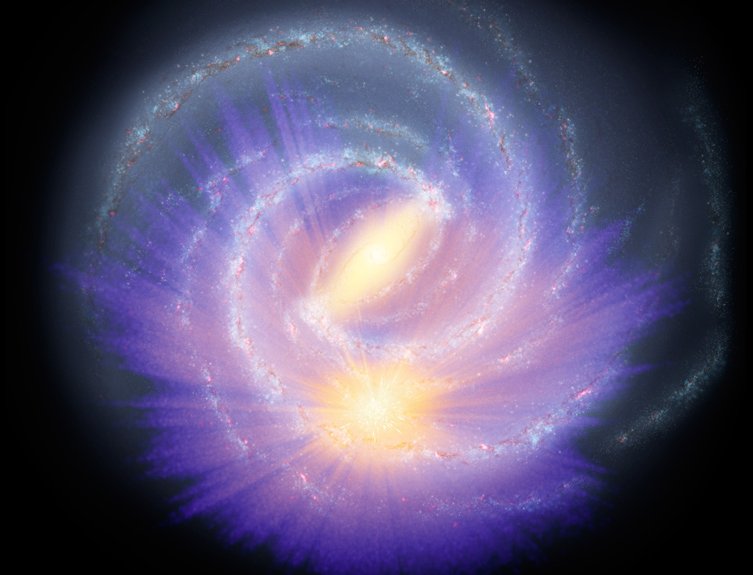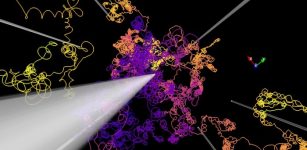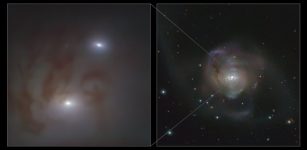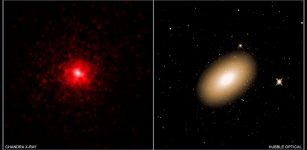Mapping Of Galactic Bar In The Milky Way By Gaia
Eddie Gonzales Jr. – MessageToEagle.com – Researchers created a map of the bar-shaped collection of stars at the center of our Milky Way galaxy, by combining ESA’s Gaia mission’s second data release (DR2) with complementary observations by ground- and space-based telescopes, the catalog
The unprecedented catalog contains the brightness, positions, distance indicators and motions across the sky for more than one billion stars in our Milky Way galaxy, along with information about other celestial bodies.
 Display of Gaia data combined with other surveys and StarHorse code over an illustration of the Milky Way. A bar structure is clearly visible in the middle. Credit: NASA/JPL-Caltech/R. Hurt; Starhorse Overlay: A. Khalatyan
Display of Gaia data combined with other surveys and StarHorse code over an illustration of the Milky Way. A bar structure is clearly visible in the middle. Credit: NASA/JPL-Caltech/R. Hurt; Starhorse Overlay: A. Khalatyan
“We looked in particular at two of the stellar parameters contained in the Gaia data: the surface temperature of stars and the ‘extinction’, which is basically a measure of how much dust there is between us and the stars, obscuring their light and making it appear redder,” Friedrich Anders ICCUB member and lead author of the new study, conducted by researchers from the Institute of Science Cosmos of the University of Barcelona and from the Leibniz Institute for Astrophysics Potsdam (Germany), said in a press release.
“These two parameters are interconnected, but we can estimate them independently by adding extra information obtained by peering through the dust with infrared observations.”
“With the second Gaia data release, we could probe a radius around the Sun of about 6500 light years, but with our new catalogue, we can extend this ‘Gaia sphere’ by three or four times, reaching out to the centre of the Milky Way,” explains co-author Cristina Chiappini from Leibniz Institute for Astrophysics Potsdam, Germany, where the project was coordinated.
At the center of our galaxy, the data clearly reveals a large, elongated feature in the three-dimensional distribution of stars: the galactic bar.
“We know the Milky Way has a bar, like other barred spiral galaxies, but so far we only had indirect indications from the motions of stars and gas, or from star counts in infrared surveys. This is the first time that we see the galactic bar in three-dimensional space, based on geometric measurements of stellar distances,” says Friedrich Anders.
“Ultimately, we are interested in galactic archaeology: we want to reconstruct how the Milky Way formed and evolved, and to do so we have to understand the history of each and every one of its components,” adds Cristina Chiappini.
Written by Eddie Gonzales Jr. – MessageToEagle.com Staff
Related Posts
-
 Search For The Origin Of Cosmic Rays And New Computer Simulation
No Comments | Sep 14, 2022
Search For The Origin Of Cosmic Rays And New Computer Simulation
No Comments | Sep 14, 2022 -
 Peculiar ‘Ravioli-Like’ Shapes Of Inner Moons Of Saturn – How Did They Form?
No Comments | May 29, 2018
Peculiar ‘Ravioli-Like’ Shapes Of Inner Moons Of Saturn – How Did They Form?
No Comments | May 29, 2018 -
 Closest Pair Of Supermassive Black Holes Yet – Discovered By Very Large Telescope
No Comments | Nov 30, 2021
Closest Pair Of Supermassive Black Holes Yet – Discovered By Very Large Telescope
No Comments | Nov 30, 2021 -
 Distant Galaxy Markarian 1216 Packed With More Dark Matter Than Expected
No Comments | Jun 4, 2019
Distant Galaxy Markarian 1216 Packed With More Dark Matter Than Expected
No Comments | Jun 4, 2019 -
 Elusive High-Energy Particle Detected During Star’s Destruction
No Comments | Mar 1, 2021
Elusive High-Energy Particle Detected During Star’s Destruction
No Comments | Mar 1, 2021 -
 New Horizons’ Evocative Farewell Glance at Ultima Thule
No Comments | Feb 11, 2019
New Horizons’ Evocative Farewell Glance at Ultima Thule
No Comments | Feb 11, 2019 -
 New Monster Black Hole ‘Practically In Our Back Yard’ – Discovered
No Comments | Oct 20, 2022
New Monster Black Hole ‘Practically In Our Back Yard’ – Discovered
No Comments | Oct 20, 2022 -
 Dying Stars’ Cocoons Might Explain Fast Blue Optical Transients
No Comments | Apr 27, 2022
Dying Stars’ Cocoons Might Explain Fast Blue Optical Transients
No Comments | Apr 27, 2022 -
 Debris From Destroyed Planets Impacts Surface Of A White Dwarf Star – Observation
No Comments | Feb 9, 2022
Debris From Destroyed Planets Impacts Surface Of A White Dwarf Star – Observation
No Comments | Feb 9, 2022 -
 Six Galaxies Undergoing Sudden, Dramatic Transitions – New Observations
No Comments | Sep 19, 2019
Six Galaxies Undergoing Sudden, Dramatic Transitions – New Observations
No Comments | Sep 19, 2019
